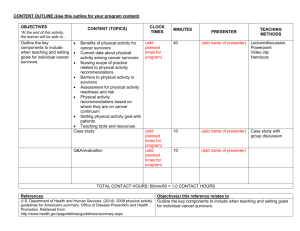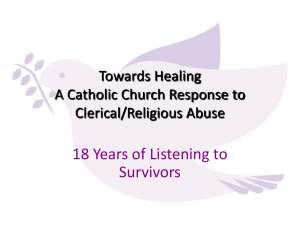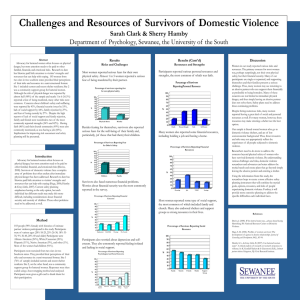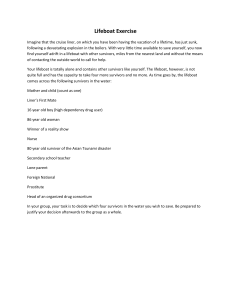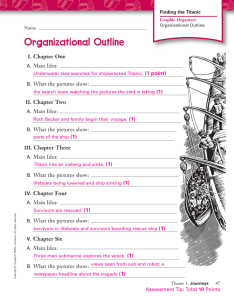Collecting better FVPSA data
advertisement
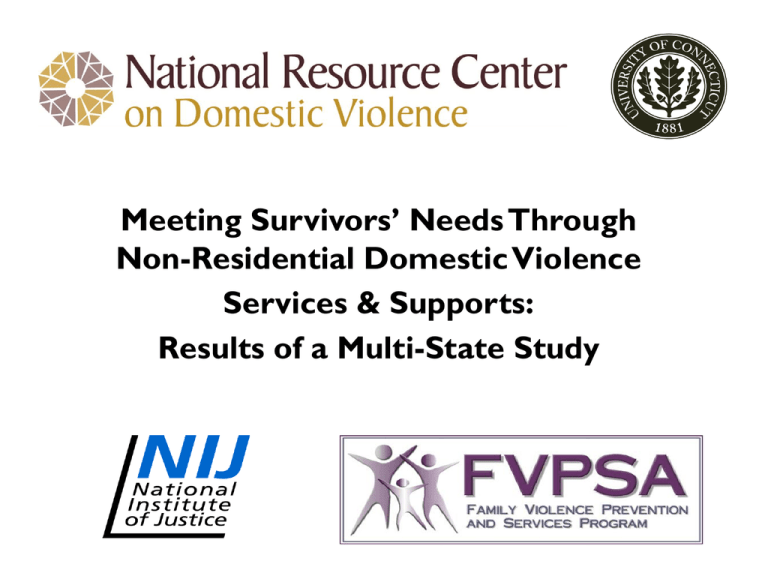
Meeting Survivors’ Needs Through Non-Residential Domestic Violence Services & Supports: Results of a Multi-State Study Study Overview Collaboration between the National Resource Center on Domestic Violence and the UConn School of Social Work Federal funding by the Family Violence Prevention & Services Administration office of DHHS; administered by National Institute of Justice Collaboration with DV Coalitions & programs across 4 states and within 4 culturally-specific organizations who have a national presence Methodology: Two phases of outreach & data collection -- surveys and focus groups Study Goals Learn more about what domestic violence survivors want when they come to programs for supportive services, the extent to which survivors have had their service expectations met, and survivors’ assessment of immediate outcomes associated with the services they receive. Learn more about how survivors’ experiences, needs and immediate outcomes vary across demographic and domestic violence program characteristics. Identify multi-level factors associated with survivors’ positive service experiences. Develop recommendations for domestic violence programs across the country for how they might improve their services. Survey Methodology Collaborated with DV Coalitions & programs across 4 states: Alabama Illinois Massachusetts Washington Collaborated with 4 culturally-specific DV organizations & their associated programs across the nation: Asian & Pacific Islander Institute on Domestic Violence (APIIDV) Casa de Esperanza Institute on Domestic Violence in the African American Community (IDVAAC) Women of Color Network (WOCN) Recruited 90 DV programs who distributed the survey to survivors with 2+ contacts over a 9 month period (April – December 2010) Survey translated into 10 languages: Arabic, Chinese, French, Korean, Polish, Portuguese, Russian, Spanish, Tagalog, and Vietnamese Participating DV Programs Program Features Avg. Range Number (#) of program staff (med. = 13) 15.59 1 - 70 # of FTEs (full-time equivalents) 10.93 1 – 43.50 # of volunteers per month (med. = 7.5) 18.90 0 - 300 $28,881 $19 - $38,000 1,213 26 – 8,519 24 3 - 41 Starting salary: Advocate # of persons receiving services within past year Years program has been in existence Program Description % Dual program: Domestic violence & sexual assault 27.9% Culturally-specific program 27.5% Program offers both shelter & non-residential services 78.7% Program receives FVPSA funding (10 no response; 5 DK) 65.0% Participating DV Programs: Languages Spoken by Program Staff & Volunteers American Sign Language Haitian Creole Russian Amharic Hebrew Samoan Arabic Hindi Serbian Bangla/Bengali Indonesian Setswana Bosnian Italian Sinhala Bulgarian Japanese Somali Cambodian/Khmer Korean Spanish Cantonese Kurdish Tagalog Cape Verdean/Criuolo Laotian Tai-Pan Creole Malayalam Tamil Croatian Mandarin Telugu English Mien Thai Farsi Nepali Ukrainian French Polish Urdu German Portuguese Vietnamese Gurajati Punjabi Yoruba Survey: Language Completed In Language N = 1466 Percent Arabic 6 .4% Chinese 13 .9% English 1013 69.1% Korean 16 1.1% Portuguese 15 1.0% Russian 6 .4% Spanish 374 25.5% Vietnamese 23 1.6% Demographics: Race/Ethnicity N = 1416 Percent 213 15.1% African 8 0.6% Asian/Asian American 96 6.8% Hispanic/Latino-a 453 32.1% Middle Eastern 8 0.6% Multi-Racial 37 2.6% Native American/Alaska Native 28 2.0% Native Hawaiian/Pacific Islander 1 0.1% White/Caucasian 552 39.1% Other 15 1.1% African American/Black Demographics: Age & Education Age 17 or > 18-20 N =1416 % 89 6.3% 58 Highest Level of Education N =1407 % 8th grade or less 148 10.5% 9th – 11th 323 23.0% High School Grad. or GED 341 24.2% Some college 335 23.8% College Grad. 201 14.3% Advanced Degree 59 4.2% 4.1% 21-30 345 24.4% 31-40 432 30.5% 41-50 320 22.6% 51-60 129 9.1% 61-70 34 2.4% Over 70 9 0.6% Demographics: Gender & Sexual Orientation Gender N = 1417 % 1355 95.6% Male 60 4.2% Transgender 2 0.1% N = 1295 % 1214 95.6% Lesbian/Gay 20 1.4% Bisexual 36 2.5% Other 25 1.7% Female Sexual Orientation Heterosexual Demographics: History in U.S. N = 1262 % 585 46.4% 69 5.5% At least one of my grandparents came to the U.S. from another country 135 10.7% My ancestors were here before my grandparents were born 473 37.5% N = 525 % 32 6.1% 367 125 70.0% 23.9% to the U.S. from another country I came At least one of my parents came to the U.S. from another country I came to the U.S. from another country, and I am a…. Refugee Immigrant Other Demographics: Disability & Financial Situation Doyou consider yourself to have a disability or disabling condition(s)? N = 1317 % Yes 277 21% No 1040 79% Current financial situation: N = 1333 % I simply can’t pay my bills. 324 24.3% I have trouble paying regular bills. 270 20.3% I can pay my bills but a big expense would cause a hardship. 389 29.2% I can easily pay my bills, but need to be careful. 188 14.1% I do not worry about paying for things I want and need. 157 11.8% Top 10 Sources: First Heard about DV Program N % 284 19.4% 2. DV staff, including other DV program 246 16.8% 3. 231 15.8% 4. People at court 183 12.5% 5. Family member 164 11.2% 6. Social service agency staff, incl. homeless shelter 111 7.6% 7. Mental health counselor/therapist 101 6.9% 8. Other specify: School 94 6.4% 9. Flyer/brochure/poster 83 5.7% 10. Health care provider 78 5.3% 1. Friend(s) Police Types of Services Currently Being Used 75% 57% 56% 36% Differences in Services Currently Being Used by Race/Ethnicity Support Group Mean of total sample = 57% % Counseling Mean of total sample = 56% % African American 61.5% African American 56.0% Asian 41.4% Asian 73.8% Hispanic 60.3% Hispanic 53.8% White/Caucasian 56.3% White/Caucasian 55.0% Support Services Mean of total sample = 75% % Legal Mean of total sample = 36% % African American 79.0% African American 22.4% Asian 81.3% Asian 62.2% Hispanic 80.0% Hispanic 47.9% White/Caucasian 70.3% White/Caucasian 29.3% Differences in Services Currently Being Used By Whether Born In or Outside U.S. Support Group Mean of total sample = 56% % 60.1% Born outside the U.S. 59.4% 54.2% U.S. born 53.3% Mean of total sample = 57% % Born outside the U.S. U.S. born Support Services Mean of total sample = 75% Counseling % Legal Mean of total sample = 36% % Born outside the U.S. 82.5% Born outside the U.S. 48.9% U.S. born 70.3% U.S. born 26.7% Top 10: Services & Supports Wanted % of US born % of born not US 1. Talking to someone who understands my situation. 96.4 97.2 2. Support to make decisions and changes in my life. 92.7 91.5 3. Finding out who to call or where to get help. 92.1 88.6 4. Learning more about why/how DV happens. 90.6 88.2 5. Information about counseling options. 85.4 84.7 6. Help being safe from the person abusing me. 80.4 83.8 7. Hearing what other people have done in similar situations. * 82.5 76.2 8. Help staying in my community safely. 76.2 74.8 9. Information about my legal rights and options. 70.6 78.3 10. Help with access to legal services. 64.5 72.9 Additional Services & Supports Wanted Type of Help and Ranking Out of 54 % of % of born US born not US 14. Help with previous/other forms of abuse * 60.4 45.5 16. Help staying in my relationship safely 76.2 74.8 23. Help with mental health services 34.1 35.4 27. Help related to custody of my children * 31.6 39.8 30. Help with children, related to their abuse 29.3 34.3 32. Help for the person who hurt me 28.5 29.7 36. Help with reproductive/women’s health issues * 17.8 38.3 37. Help with job/job training 24.9 26.3 44. Help with immigration-related issues * 3.0 42.5 48. Help with substance abuse services 15.3 10.7 Types of Services Sought for Children Percentage based on those who sought at least one (n=845) Help with counseling for my children. Help with other (local/state/federal) benefits for my children. Help related to custody of my children. Help maintaining safe visitation with my children. Help with children related to their abuse. Help with child protection hearing or requirements. Help with child care. Help with child support. Help with health care for my children. Help meeting the needs related to my child’s disability. % 66.6% 62.7% 62.5% 59.9% 57.0% 46.2% 45.9% 45.0% 43.6% 19.0% 11 Factors: Services & Supports Wanted % Who Wanted 1 or More 1. Information/support needs (6 items) 93% 2. Safety needs (4 items) 88% 3. Legal advocacy needs (4 items) 76% 4. Child-related needs (9 items) 65% 5. Economic needs (7 items) 59% 6. Victimization-related needs (2 items) 57% 7. Family-related needs (3 items) 57% 8. Physical/mental health needs (4 items) 51% 9. Criminal legal needs (3 items) 32% 10. Immigration-related needs (5 items) 30% 11. Vulnerability-related needs (3 items) 24% Total Number of Services Wanted by Demographic Features (overall mean = 22.18) Current Financial Status Mean Ability to speak English Mean I simply can’t pay my bills 23.96 Not at all 24.52 I have trouble paying my bills. 21.00 Not well 23.97 I can pay regular expenses, but a big expense would cause a hardship. 20.00 Okay 24.85 Well 23.26 Very well 21.20 I can easily pay my bills. 18.50 I do not worry about paying for things I want and need. 17.00 History in U.S. Mean Born outside the U.S. 23.98 U.S. born 20.65 Significant Predictors •Less completed education • Younger age Close: • Less ability to speak English • More financial difficulty Top 10: Services & Supports Received Scale: 3: I got all of the help of this kind that I wanted 2: I got some of the help of this kind that I wanted 1: I wanted this kind of help but didn’t get any Average 1. Talking to someone who understands my situation. 2.82 2. Finding out who to call or where to get help. 2.81 3. Learning more about why/how DV happens. 2.80 4. Help being safe from the person abusing me. 2.79 5. Support to make decisions and changes in my life. 2.78 6. Help with translation/interpretation. 2.77 7. Help staying in my relationship safely. 2.75 8. Information about counseling options. 2.74 9. Help staying in my community safely. 2.74 10. Help with protective or restraining order. 2.73 Top 10: Services & Supports Wanted but NOT Received * Percentage who wanted this kind of help, but reported they didn’t get any %* Overall % who wanted service 1. Help learning to drive. 28.9% 9.1% 2. Help with a job or job training. 28.5% 26.9% 3. Help paying rent/utilities. 25.5% 37.8% 4. Help with cash assistance/vouchers. 22.6% 36.8% 5. Help for the person who hurt me. 21.0% 31.8% 6. Help with transportation. 20.9% 29.4% 7. Help with financial matters, such as budgeting. 20.3% 33.4% 8. Help with child support. 19.1% 26.5% 9. Help with contacting family who are far away. 18.8% 19.0% 10. Help getting housing. 18.7% 35.9% Satisfaction with Services & Supports Survivor Outcomes Percentage who said “yes”, the statement describes how they feel. % I feel more hopeful about the future. 95.4% I know more ways to plan for my safety. 95.0% I know that I will achieve the goals I set for myself. 94.6% I know more about my rights and options. 93.4% I feel more comfortable asking for help. 93.3% I feel more confident in making decisions. 92.7% I feel like I can do more things. 91.3% I know more about community resources. 88.5% I get more support from family & friends. 78.5% Feedback on Outcomes I learned how much I'm worth and my rights as a person and a woman. I have a better life together with my kids and we live in peace and harmony. Survivor from Illinois It has helped me a lot in the form of knowing that I'm worth something and I'm someone important. And in the group I feel comfortable again to be able to accept friendships and to have trust in myself. Survivor from Washington I feel stronger and do feel more hopeful towards the future. Survivor from program identified by APIIDV Focus Group Populations: 10 Groups, N = 73 Culturally-specific populations: Asian/Pacific Islander African American Hispanic/Latino(a) (2 groups) Portuguese-speaking Brazilian immigrants Other targeted populations: LGBTQ Men Older adults Survivors living in rural areas Survivors in recovery from substance abuse Implications—for DV Programs Survivors report high levels of satisfaction with the services and supports they receive, and with program staff, suggesting that DV programs should continue to offer a broad array of services and continue with staff training efforts. High correlation between services and supports “wanted” and those “received” suggests that programs are meeting the needs of survivors in many areas; but there is room for improvement in meeting economic needs, legal advocacy needs, and supports for children. Outcomes suggest that DV programs are creating positive change the lives of survivors. Implications—Training and Practice DV survivors have multiple & complex needs; need comprehensive & collaborative approach. Many survivors want/need to remain in a relationship with the person who has abused them—importance of safety planning that takes this into account, and of services for people who are abusing. Needs related to children are primary among mothers. Culturally appropriate/competent services are vital. Resources RESOURCES on VAWnet.org Meeting Survivors’ Needs Study Resource Page www.vawnet.org/research/MeetingSurvivorsNeeds Research Resources www.vawnet.org/research/ Use of Data & Statistics www.VAWnet.org/research/use-of-data QUESTIONS OR COMMENTS ABOUT THE STUDY? Please contact research@nrcdv.org
